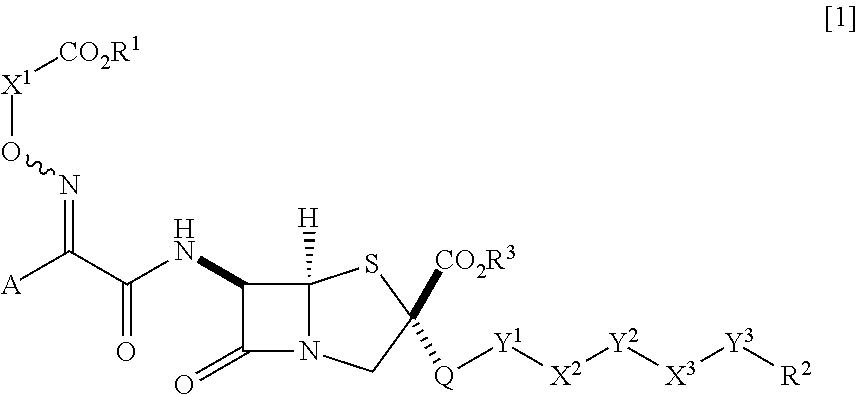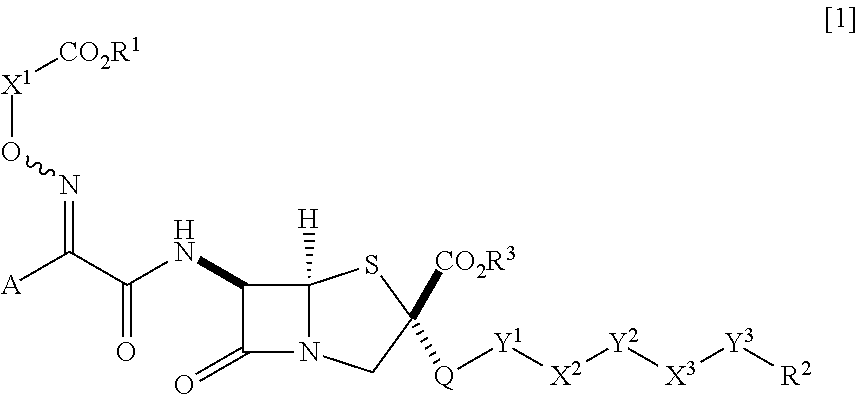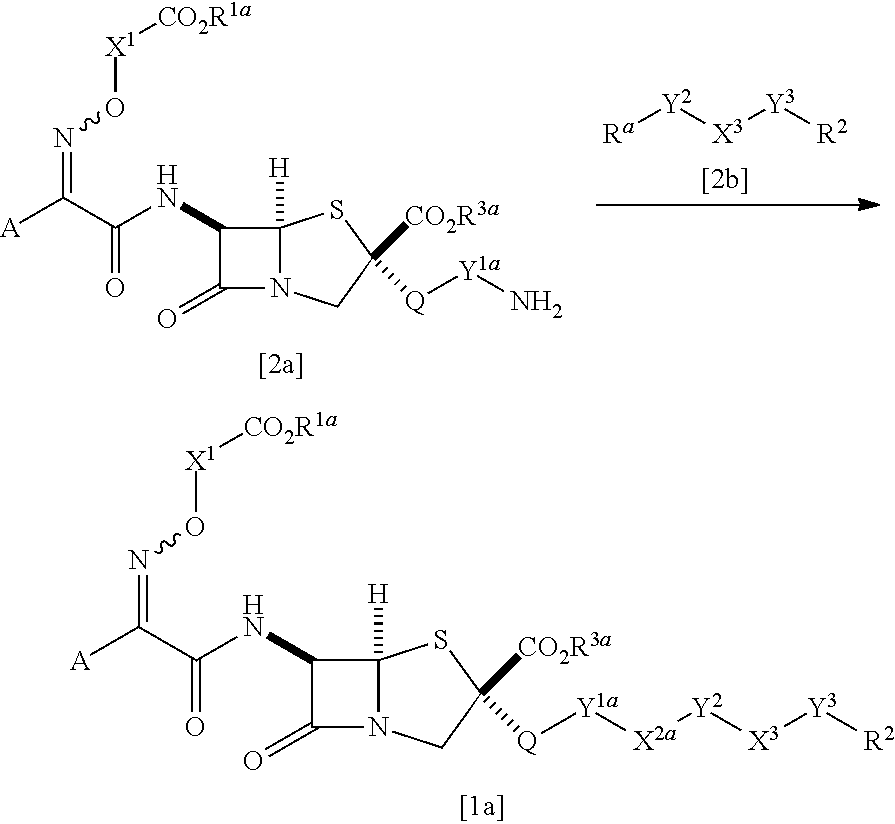Novel penam derivative or salt thereof, pharmaceutical composition, and applications thereof
a penam derivative and penam salt technology, applied in the field of new penam derivatives, can solve the problems of long hospital stay of patients, and achieve the effect of few effective therapeutic agents
- Summary
- Abstract
- Description
- Claims
- Application Information
AI Technical Summary
Benefits of technology
Problems solved by technology
Method used
Image
Examples
reference example 1
[0480]
[0481]THF (400 mL) was added to 2-chloro-3,4-bis((4-methoxybenzyl)oxy)benzoic acid (40.0 g), and the mixture was stirred under ice cooling. At the same temperature, DMF (361 μL) was added to the reaction mixture, and then oxalyl dichloride (14.2 g) was added dropwise thereto. The reaction mixture was stirred at room temperature for 1 hour, and then oxalyl dichloride (14.2 g) was added dropwise thereto. The reaction mixture was stirred at room temperature overnight, and then IPE (400 mL) was added to the reaction mixture. Solids were collected by filtration and washed with IPE. The solids were dried, thereby obtaining 2-chloro-3,4-bis((4-methoxybenzyl)oxy)benzoyl chloride (30 g) as white solids.
[0482]NMR (DMSO-d6): 3.74 (3H, s), 3.78 (3H, s), 4.88 (2H, s), 5.18 (2H, s), 6.82-6.89 (2H, m), 6.95-7.02 (2H, m), 7.23 (1H, d, J=9.2 Hz), 7.26-7.33 (2H, m), 7.41-7.49 (2H, m), 7.62 (1H, d, J=8.4 Hz)
reference example 2
[0483]
Reference Example 2 (1)
[0484]THF (20 mL), water (20 mL), sodium hydrogen carbonate (281 mg), and 2-chloro-3,4-bis((4-methoxybenzyl)oxy)benzoyl chloride (500 mg) were sequentially added to ethyl 3-aminopropanoate hydrochloride (257 mg). The reaction mixture was stirred at room temperature for 4 hours, ethyl acetate (50 mL) and water (50 mL) were then added to the reaction mixture, and the organic layer was separated. The organic layer was washed with a saturated aqueous sodium chloride solution and dehydrated and dried over anhydrous sodium sulfate. The solvent was distilled away under reduced pressure, thereby obtaining a target substance (600 mg) as yellow solids.
reference example 2 (
2)
[0485]Methanol (5.8 mL), THF (5.8 mL), and a 2 mol / L aqueous sodium hydroxide solution (4.5 mL) were added to the compound (600 mg) obtained in Reference Example 2 (1), and the mixture was stirred at room temperature overnight. Ethyl acetate (20 mL) and water (20 mL) were added to the reaction mixture, 2 mol / L hydrochloric acid was added thereto such that the pH was adjusted to 1.8. The reaction mixture was stirred at room temperature for 30 minutes, and solids were collected by filtration. The solids were dried under reduced pressure, thereby obtaining 3-(2-chloro-3,4-bis((4-methoxybenzyl)oxy)benzamido)propionic acid (488 mg) as white solids.
[0486]NMR (DMSO-d6): 2.48 (2H, t, J=6.8 Hz), 3.39 (2H, q, J=6.7 Hz), 3.75 (3H, s), 3.77 (3H, s), 4.87 (2H, s), 5.15 (2H, s), 6.87 (2H, dd, J=6.8, 2.0 Hz), 6.97 (2H, dd, J=6.6, 1.8 Hz), 7.11 (1H, d, J=8.8 Hz), 7.18 (1H, d, J=8.4 Hz), 7.31 (2H, dd, J=6.8, 2.0 Hz), 7.43 (2H, d, J=8.8 Hz), 8.33 (1H, t, J=5.4 Hz), 12.22 (1H, s)
PUM
 Login to View More
Login to View More Abstract
Description
Claims
Application Information
 Login to View More
Login to View More - R&D
- Intellectual Property
- Life Sciences
- Materials
- Tech Scout
- Unparalleled Data Quality
- Higher Quality Content
- 60% Fewer Hallucinations
Browse by: Latest US Patents, China's latest patents, Technical Efficacy Thesaurus, Application Domain, Technology Topic, Popular Technical Reports.
© 2025 PatSnap. All rights reserved.Legal|Privacy policy|Modern Slavery Act Transparency Statement|Sitemap|About US| Contact US: help@patsnap.com



